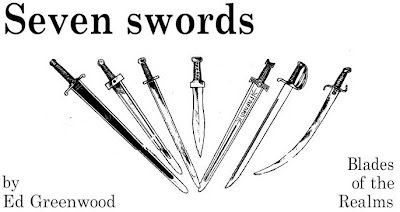REPOST: The Articles of Dragon: "Seven Swords"
 Like his "Pages from the Mages," Ed Greenwood's "Seven Swords" from issue #74 of Dragon (June 1983) is an article I remember reading for the first time very vividly. Not only was I keen for more information about Greenwood's then-mysterious Forgotten Realms setting, but I had come recognize the man as one of the more clever and imaginative writers to appear in Dragon's pages. A big part of Greenwood's appeal is the way that he could make something as seemingly banal as sword +1 and make it interesting – and he did it without having to introduce a host of new powers or abilities into the game.
Like his "Pages from the Mages," Ed Greenwood's "Seven Swords" from issue #74 of Dragon (June 1983) is an article I remember reading for the first time very vividly. Not only was I keen for more information about Greenwood's then-mysterious Forgotten Realms setting, but I had come recognize the man as one of the more clever and imaginative writers to appear in Dragon's pages. A big part of Greenwood's appeal is the way that he could make something as seemingly banal as sword +1 and make it interesting – and he did it without having to introduce a host of new powers or abilities into the game.What "Seven Swords" does is present seven different magical weapons, none of which is more potent than a sword +3. Each of these swords gets an extensive description of both its physical and magical properties. Amusingly, it's often the physical description that really sets these swords apart from the pack. Whether it's the huge cabochon-cut black sapphire in the grip of Adjatha, the six matched bloodstones set in the bronze blade of Ilbratha, or the rearing serpents who make the guard of Shazzellim, Greenwood makes each of these weapons unique in appearance as well as abilities. This is a small detail that many referees overlook, concentrating instead on game mechanical effects. Greenwood doesn't skimp on these either, but they're only one facet of what makes the titular swords special.
Each weapon also includes a "lore" section, detailing the history of the blade, from its forging to the present day. It's this section that I really ate up as a younger man. Re-reading them in preparation for this post, I can completely understand why that was the case. The lore Greenwood presents isn't extensive – no more than four or five short paragraphs in most cases – but it's evocative. It's suggestive of adventures and, better still, it gives even a lowly sword +1 an air of antiquity and individuality that makes it a weapon worth holding on to even when better weapons come along. That was probably the biggest lesson "Seven Swords" taught me: game mechanics aren't always what make a magic item special. It's a lesson I've kept with me all these years and one I'd like to see adopted more broadly.
Published on February 17, 2025 21:00
No comments have been added yet.
James Maliszewski's Blog
- James Maliszewski's profile
- 3 followers
James Maliszewski isn't a Goodreads Author
(yet),
but they
do have a blog,
so here are some recent posts imported from
their feed.



